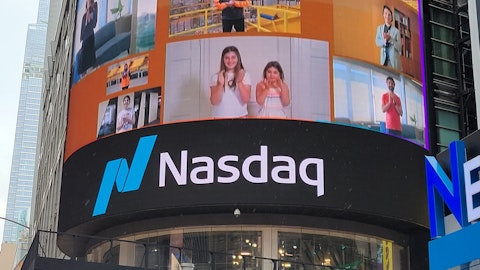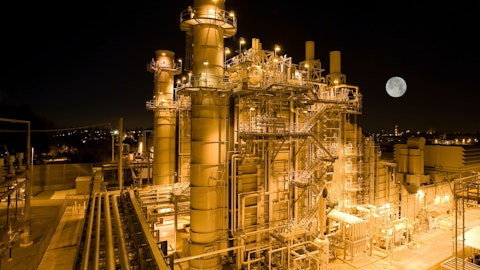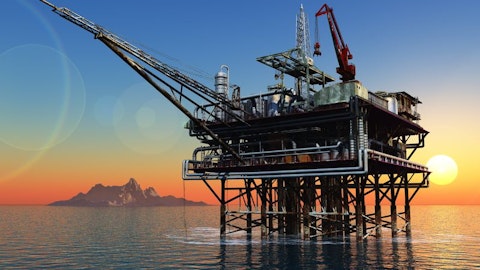APA Corporation (NASDAQ:APA) Q1 2023 Earnings Call Transcript May 4, 2023
Operator: Good day, and thank you for standing by. Welcome to the APA Conference Call. . Please be advised that today’s conference is being recorded. I would now like to hand the conference over to your speaker today, Gary Clark, Vice President of Investor Relations.
Gary Clark: Good morning, and thank you for joining us on APA Corporation’s First Quarter 2023 Financial and Operational Results Conference Call. We will begin the call with an overview by CEO and President, John Christmann. Steve Riney, Executive Vice President and CFO, will then provide further color on our results and outlook. Also on the call and available to answer questions are Dave Pursell, Executive Vice President of Development; Tracey Henderson, Executive Vice President of Exploration; and Clay Bretches, Executive Vice President of Operations. Our prepared remarks will be approximately 12 minutes in length with the remainder of the hour allotted for Q&A. In conjunction with yesterday’s press release, I hope you have had the opportunity to review our first quarter financial and operational supplement, which can be found on our Investor Relations website at investor.apacorp.com.
Please note that we may discuss certain non-GAAP financial measures. A reconciliation of the differences between these non-GAAP financial measures and the most directly comparable GAAP financial measures can be found in the supplemental information provided on our website. Consistent with previous reporting practices, adjusted production numbers cited in today’s call are adjusted to exclude noncontrolling interest in Egypt and Egypt tax barrels. I’d like to remind everyone that today’s discussion will contain forward-looking estimates and assumptions based on our current views and reasonable expectations. However, a number of factors could cause actual results to differ materially from what we discuss today. A full disclaimer is located with the supplemental information on our website.
And with that, I will turn the call over to John.
John Christmann: Good morning, and thank you for joining us. On today’s call, we will review our first quarter highlights, update our operational progress and comment on our outlook for the remainder of the year. For the last several years, we have been navigating a volatile price environment, and this has been amplified recently with the ups and downs of global oil prices, extreme moves in global LNG pricing and the rapid decline in U.S. natural gas prices. Despite this volatility, we are constructive on long-term prices for oil, natural gas and LNG. Based on this fundamental belief, we plan to invest over the long term for sustainable low single-digit production growth at attractive returns. That said, we cannot ignore price volatility and will, therefore, seek to moderate our investment plans during periods of significant price weakness.
We must also be responsive to changing governmental tax and regulatory regimes within our countries of operations. Fortunately, our diversified portfolio provides us optionality, and we maintain the flexibility to adjust our investment plans relatively quickly. In 2023, we have demonstrated this by reducing natural gas directed activity and even curtailing production in response to extreme Waha price dislocations. We also made the decision to reduce spending in the North Sea as the recently enacted energy profits levy has resulted in less competitive return opportunities than in the U.S. and Egypt. So while you should generally expect us to invest at a steady pace for long-term returns and moderate growth, you will also see periods where we respond to external influences by adjusting or redirecting capital activity.
Turning now to our first quarter results, which are characterized by strong operational performance and good cost control. APA met or exceeded production guidance in each of our 3 regions. Total adjusted production was 4,000 BOEs per day, above the top end of our guidance range. Adjusted oil production also exceeded expectations, led by performance in the Permian and the North Sea. Capital investment during the period was slightly below guidance, and our average operating drilling rig count remained steady in the quarter with 17 in Egypt, 5 in the Permian Basin and 1 semisubmersible in the North Sea. In the U.S., we connected 17 new wells, and as planned, most of these went online in the back half of the quarter. While timing of well connections can drive production variances, on a quarter-to-quarter basis, we are continuing to see significant benefits from the steady pace of our drilling program.
As expected, first quarter oil production declined sequentially from the fourth quarter. However, we remain on track to deliver a significant uptick in the second and third quarters. Permian activity this year will be concentrated primarily on oil development in the Southern Midland Basin and oil-weighted development in the Delaware Basin. At Alpine High, we are currently testing a new 3-well pad at a constrained rate. Beyond this, we are ramping down our planed 2023 lean gas drilling activity in the Permian due to the prevailing weakness in Waha natural gas prices. This will result in an upstream capital reduction of approximately $100 million but should have no material impact on our full year U.S. production guidance. We are pleased with the results at Alpine High and will return when Waha prices improve.
In Egypt, gross oil production increased by approximately 1,200 barrels per day compared to the fourth quarter. New well connections, recompletion activity and exploration success were all consistent with our expectations, and we are beginning to see positive contribution from our higher activity pace. For the second quarter, however, we are forecasting that Egypt gross volumes will be roughly unchanged as we have recently experienced some production disruptions, most of which are temporary. Despite this, our full year Egypt production guidance has not changed. Turning now to the North Sea. Our production exceeded expectations in the first quarter, driven by strong facility operating efficiency. We are projecting second quarter average daily production will be in line to slightly below the first quarter as scheduled platform maintenance and expected return to more normalized facility operating efficiency will be mostly offset by contribution from a new well, which was placed online in late March.
In Suriname, we continue to progress toward an oil hub development project with activity in the first half of 2023 focused on appraising Krabdagu. We have completed the flow test on the first appraisal well and are currently in the pressure buildup phase. Results of this well thus far are in line with expectations. The second Krabdagu appraisal well is currently drilling and we’ll provide more information on next steps in the future. On the ESG front, we delivered another excellent quarter of safety performance and are making good progress toward our longer-term emissions goal of implementing projects to eliminate 1 million tons of CO2 equivalent emissions by year-end 2024. We reduced routine upstream flaring in Egypt by 40% last year, which gave us an excellent start on this goal.
In 2023, we plan to further reduce flaring in Egypt and focus on converting diesel combustion for power generation to field gas, which will reduce both cost and net emissions. In closing, APA has the portfolio and the operational flexibility to respond quickly to near-term commodity price volatility, and we are managing our capital activity accordingly. We remain committed to returning a minimum of 60% of our free cash flow to shareholders this year via dividends and share repurchases. Longer term, despite many cross currents, we believe the investment case for APA and the E&P industry is strong, and the outlook for hydrocarbon prices and fundamentals is very constructive. And with that, I will turn the call over to Steve Riney.

SFIO CRACHO/Shutterstock.com
Stephen Riney: Thanks, John. For the first quarter, under generally accepted accounting principles, APA reported consolidated net income of $242 million or $0.78 per diluted common share. As usual, these results include items that are outside of core earnings. The most significant of these items was a $174 million charge related to the remeasurement of our deferred tax liability in the U.K. caused by the most recent increase in the energy profits levy. This was partially offset by the release of a valuation allowance on U.S. deferred tax assets. Excluding these and other smaller items, adjusted net income for the first quarter was $372 million or $1.19 per diluted common share. Free cash flow, as we define it, which excludes changes in working capital, was $272 million in the quarter, 81% of which we returned to shareholders through dividends and share repurchases.
As John noted, it was a strong quarter for production, and costs were a good bit under plan. G&A expense was $65 million, significantly below both the prior quarter and the same quarter last year. This is a result of APA’s lower stock price at quarter end and the mark-to-market impact on previously accrued share-based compensation. Excluding this mark-to-market impact, underlying quarterly G&A costs remained stable at roughly $100 million. LOE also came in a good bit below expectations primarily due to the previously mentioned mark-to-market impact of stock-based compensation programs as well as foreign currency impacts in Egypt. Switching to forward-looking guidance items. In the U.S., oil production growth is expected to return in the second quarter and should ramp further in the third quarter in conjunction with completion cadence.
Our U.S. natural gas production outlook is more muted as we are responding to weak Waha pricing with lean gas drilling reductions. In addition, we could see further lean gas production curtailments. But to be clear, further curtailments are not contemplated in our U.S. production guidance. All of this is consistent with our bias towards managing for cash flow and long-term returns, not production growth. The $100 million reduced drilling activity John noted will occur mostly in the second half of this year. With that, our full year capital budget has been reduced to $1.9 billion to $2 billion. Next, I would like to highlight our 2 material gas trading activities that are truly differential for APA, our gas transport obligations and our Cheniere gas supply contract.
Our gas transport contracts provide significant cash flow benefits during periods of dislocated Permian gas prices. We hold just over 670 million cubic feet per day of Permian Basin takeaway capacity. We purchased third-party gas in-basin for resale on the Gulf Coast, realizing a trading margin whenever the price differentials are greater than the transport cost. In the first quarter, this activity generated a net profit of $23 million. Based on current strip prices, we have increased our full year guidance for net profit from such activity to $100 million. The Cheniere agreement, which will commence on August 1, is another important commercial trading activity. This arrangement provides upside exposure to world LNG margins over Houston Ship Channel on 140 million cubic feet of natural gas per day.
For 2023, projected cash flow from this contract has come down a bit from our prior guidance due to the decline in European and Asian LNG prices. Over the past few months, we have provided potential outcomes of annualized free cash flows at different price levels related to this contract. You can find those in the appendix of our financial and operational supplement. At current strip prices, the Cheniere contract will generate and expected $175 million of free cash flow for the last 5 months of 2023. All of our guidance for both the second quarter and updated full year 2023 and can be found in our financial and operational supplement. One final item I’d draw your attention to. Looking at the balance sheet, you will notice that our revolver debt increased by a little over $400 million in the first quarter.
This was driven by an approximate $500 million increase in working capital primarily due to the paydown of accrued liabilities from December 31, but it also includes increasing accounts receivable in Egypt. Overall, we had a very good quarter to start the year. We’re benefiting from relatively stable activity levels within a portfolio that allows us to generate free cash flow and invest in the long-term sustainability of our business. And with that, I will turn the call over to the operator for Q&A.
See also 15 Free Dating Sites in USA Without Payment: 2023 List and 12 Most LGBT-Friendly Countries in Asia.
Q&A Session
Follow Apache Corp (NYSE:APA)
Follow Apache Corp (NYSE:APA)
Operator: . Our first question comes from John Freeman of Raymond James.
John Freeman: I believe the original plan was after the 3-well pad gap brought on in Alpine High in the first quarter, there was going to be those kind of a break and then there was going to be 5 additional wells that we’re going to come out at the end of the year. So is the $100 million reduction in the budget basically just coming from the removal of those 5 Alpine High wells? Or is there more to it?
David Pursell: Yes, John. This is Dave Pursell. We may have had more than 5 wells planned for the middle of the year. But if you’re trying to — there’s some moving parts in the Permian budget, but the effect is, yes, the net $100 million is essentially all the Alpine drilling, completion and facilities capital rounds up to $100 million.
John Freeman: Perfect. And then just my follow-up question. I know at some point, there was some discussions about kind of following the release of the Ocean Patriot next month that there was going to be some use of that kind of freed up comp or it might have been to add an additional rig in the Permian. I’m just — I guess, first of all, is that — would that be the case? If you were going to increase activity anywhere in the portfolio, is that likely where it would go? And sort of what commodity environment would you likely need to see to potentially add another rig in the Permian at some point in the future?
John Christmann: Well, John, I mean, we did add some more weighted drilling in the Permian with that. That was contemplated. And then you’re seeing us drop some of the gas weighted drilling at Alpine. So two effects there.
Operator: Our next Question. Our next question comes from Doug Leggate, Bank of America.
Doug Leggate: Sorry, guys, can you hear me now?
John Christmann: Can be.
Doug Leggate: All right. Sorry about that. I’m sitting in an airport. I have my new boss in on. I apologize, John. My first question is for Steve, actually. Steve, I wonder if you could just elaborate a little bit on your comments about the increase in receivables in Egypt. There’s obviously, I think, some concern events over there, the devaluation and so on might have an impact on your ability to get cash out of the country. So I’m just going to hit that right upfront and ask if you can walk us through what you’re seeing currently and whether that working capital build is in fact reversible.
Stephen Riney: Yes, Doug, let me just start with the working capital level, and we’ll work into the Egypt receivables impact on working capital. So we — I said in my prepared remarks that we’ve got about a $500 million increase in working capital in the first quarter, $300 million of that was a decrease in accrued compensation and benefits. So as you might imagine, through the year, we accrue primarily incentive compensation, both short term and long term. And we accrue that through the year. We do that every year, and then we pay it off in the first quarter of the following year. And so that’s exactly what happened. That was a — we do that every year. It was a little bit larger going from the end ’22 accrued liability to what was paid off in 2023 because of the performance, number one, but also because of the share price because it does include the long-term incentive comp, which is share price-based.
And because of — it’s a 3 years of programs and because the share price had improved over those years, that raised the cost of that. So that’s $300 million of the $500 million. There was another $100 million decrease in general accounts payable, stuff for operating expense and capital expenditures, things like that. And so that’s $400 million out of the $500 million increase in working capital. And all of those things are very common as we go from fourth quarter of 1 year to the first quarter of the next. Now there were a number of other small, mostly kind of $50 million and smaller items moving in and out of working capital. And that includes a $50 million increase in accounts receivable. And again, I’ve provided this in my prepared remarks.
Just to be completely transparent with folks because I know there’s probably some amount of concern over what’s going on in Egypt. So in the spirit of transparency, I indicated that accounts receivable in Egypt had increased $180 million. If you look at our supplement, you’ll see a working capital increase for Egypt of $224 million. That includes a number of other things like inventory and stuff like that. So $180 million in Egypt. And I don’t know, John, you want to kind of on Egypt?
John Christmann: On Egypt, just a couple of minutes here, Doug. One, we’ve been in the country for more than — almost 30 years and we’ve partnered with Egypt and EGPC and the highest levels of government the whole time. I’d say over that time period, Egypt has been through a number of challenges and successful reforms. The best thing that we can do to help Egypt and our stakeholders is to deliver oil production growth. And that’s what we’re doing while reducing our emissions. Egypt, like many other places in the world today, is going through a challenging economic time with inflation. This does have some flow-through to us, but not anything that we haven’t had to work through in the past. And in fact, there’s been more difficult times in the past.
Specifically, they are dealing with the after effects of a currency devaluation in January, and we are currently helping our Egyptian National employees through this as we have also done in the past. We maintain very deep and long-standing relationships with our Egyptian stakeholders, both at EGPC and within the government at the highest levels, I’ll say. And we are confident that they will work through this. And we are also having very constructive conversations on how to address the receivables over time currently. So we feel good and a long track record here.
Stephen Riney: Yes. And Doug, if I could just kind of add to John’s comments there a bit. So we are — it did go up $180 million in the first quarter. And I’d say that the receivables we have from Egypt are higher than historical averages, no doubt. Some of that is price and some of it is the delay in payment. But I’d just comment that, as John talked about the 30 years of history, we’ve been in this position several times. This level of receivables from Egypt is not unprecedented. It’s never a good time to have this happen, obviously. But I would say it’s not overly concerning at this point. Egypt’s credit rating has been pretty stable since it got upgraded in 2015. We watch the situation extremely closely. And as John said, we’re in active conversations about this specific issue, and we’re doing that at the very highest levels in the country. So we feel confident about this.
Doug Leggate: Just to be clear, guys, always that balance you talked about in receivables. Are you able to get cash out of the country? Or was that an accumulation of — basically because it’s the highest free cash flowing asset in your portfolio currently? Is this — are you able to get cash out of the country currently?
Stephen Riney: Yes. We are still able to get cash out of the country. That’s not the problem.




